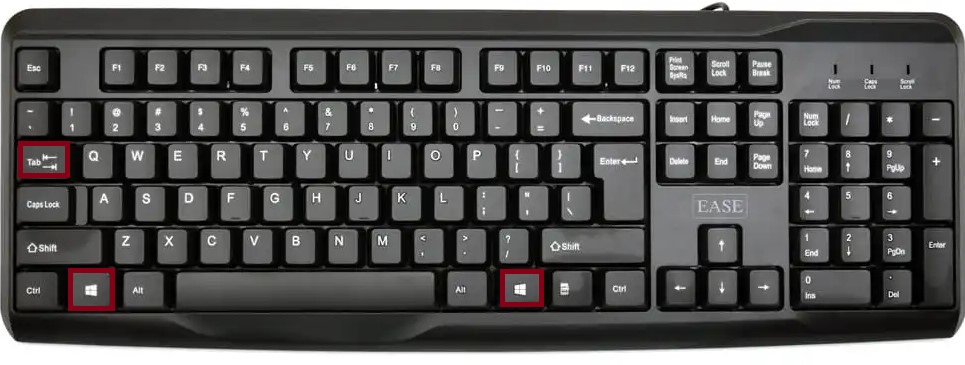The Windows + Tab keyboard shortcut is one of the most powerful productivity tools built into Windows operating systems. It opens the Task View interface, providing users with an overview of all currently open windows and desktops. Whether you are managing multiple applications, switching between tasks, or creating virtual desktops for organized workflows, Windows+Tab offers a clear and interactive way to stay on top of your work.
This article explores the Windows + Tab shortcut in-depth, including its use in Microsoft applications, its utility across other software, known issues, Mac equivalents, and practical tips for everyday and professional use.
Table of Contents
🔹 What Does Windows+Tab Do?
Pressing Windows + Tab opens Task View, a full-screen interface that shows:
- All open windows and applications
- A timeline of recent activities (in some versions)
- A sidebar to manage multiple virtual desktops

It serves as a visual alternative to Alt + Tab, allowing you to manage your workspace more intuitively and efficiently.
Unlike Alt + Tab (which is temporary and held), Windows + Tab stays open until you click on or switch to a window, desktop, or press Esc.
🔸 Use of Windows + Tab in Microsoft Applications
While Windows + Tab is a system-level shortcut and not specific to any individual app, it improves productivity across all Microsoft Office and productivity software by allowing smooth multitasking.
📄 Microsoft Word, Excel, PowerPoint
- Switch quickly between multiple documents or spreadsheets.
- Separate projects into different virtual desktops—for example, have Excel on Desktop 1 and Word on Desktop 2.
- Enhance focus by keeping unrelated windows hidden on other desktops.
📧 Microsoft Outlook
- Use Task View to navigate between Outlook and other tools like Teams, OneNote, or Calendar.
- Create a separate desktop just for communication apps—keep your inbox open and undisturbed.
💬 Microsoft Teams & OneNote
- Keep Teams and OneNote in one desktop, and all active project documents in another.
- Instantly identify which apps are running and jump to them visually.
📊 Microsoft Power BI & Project
- Handle complex data models or Gantt charts in isolation on their own desktops.
- Prevent screen clutter and reduce distractions.
🔹 Use of Windows+Tab in Other Applications
🌐 Browsers (Edge, Chrome, Firefox)
- Task View allows you to visually switch between browser windows (not individual tabs).
- Assign different browser tasks (e.g., research, dashboards) to different desktops.
🛠 Development Tools (Visual Studio, VS Code)
- Place different projects or environments on separate desktops.
- Use Task View to ensure which instance or version you are working in.
🎨 Creative Software (Adobe Suite, DaVinci Resolve)
- Isolate Photoshop work from Illustrator or Premiere Pro by placing them on separate desktops.
- Reduce RAM overload by easily closing or moving tasks from Task View.
🎮 Gaming
- Quickly close background windows before starting a game.
- Keep Discord, Game Bar, or OBS Studio open in another desktop for streaming setup.
⚠️ FAQs
While Windows + Tab is typically very reliable, a few users encounter issues:
1. Task View Doesn’t Open
- Ensure multitasking features are enabled via:
Settings > System > Multitasking
2. Timeline Not Showing
- Timeline (activity history) was deprecated in recent Windows 11 updates.
3. Virtual Desktops Missing
- In older versions of Windows 10, desktop support may be limited or require updates.
4. Performance Lag
- If you have many open applications, Task View can lag or pause momentarily.
- Close unused programs or increase system memory.
🍎 Mac Equivalent of Windows + Tab
macOS offers a few alternatives to Windows + Tab functionality:
- Control + ↑ (Mission Control): View all open windows.
- F3 key (Mission Control) on Apple keyboards.
- Command + Tab: Quickly switch between open apps (more like Alt + Tab).
For virtual desktops:
- Control + → or ← moves between desktops.
- Control + Mission Control shows all desktops and full-screen apps.
While different in key combination, the functionality is comparable through Mission Control.
✅ Summary Table
| Shortcut | Action |
|---|---|
| Windows + Tab | Opens Task View interface |
| In Word/Excel | Switch between open files or move them to virtual desktops |
| In Outlook/Teams | Organize communication apps in their own space |
| In Browsers | Navigate between different browser windows |
| Mac Equivalent | Control + ↑ (Mission Control) |
📝 Final Thoughts
The Windows + Tab shortcut is essential for anyone working with multiple applications, projects, or screens. It helps bring visual clarity, task separation, and better workflow control through its Task View and Virtual Desktop features.
Whether you’re a student writing reports, a developer switching environments, or a business professional juggling Teams, Outlook, and Excel — this shortcut saves time, boosts focus, and reduces clutter. Learning to incorporate Windows + Tab into your routine is a simple upgrade to your daily productivity.